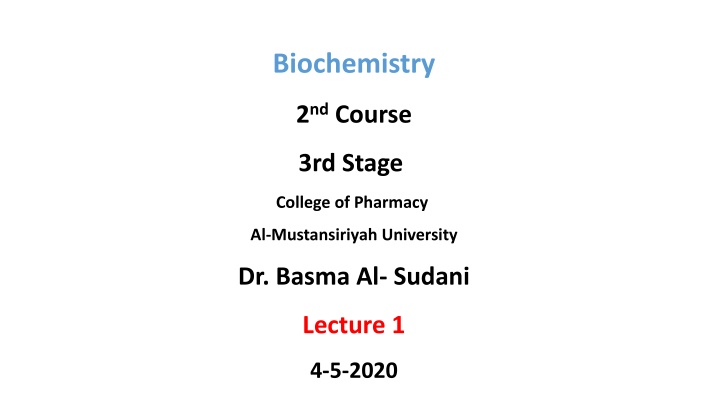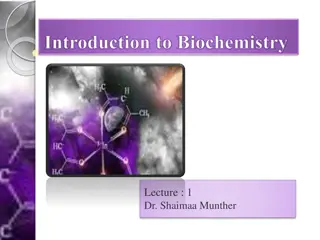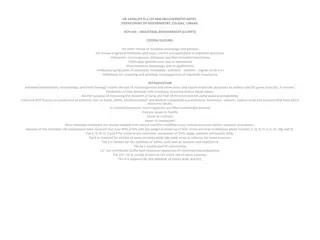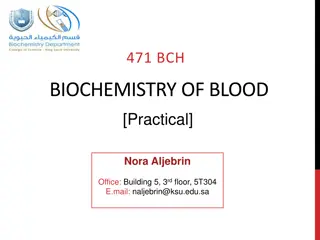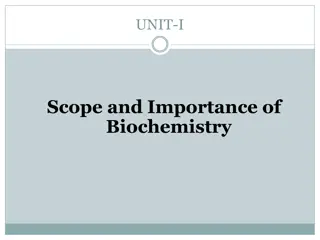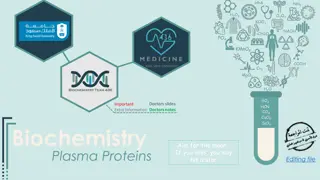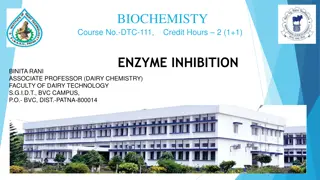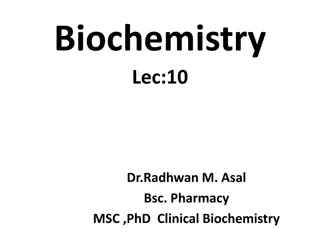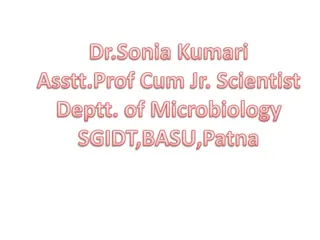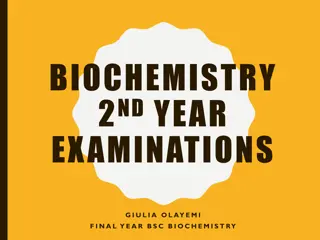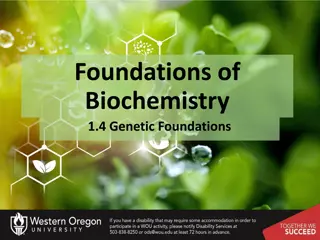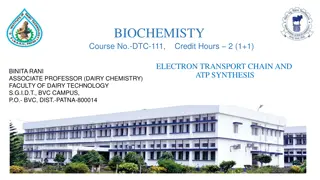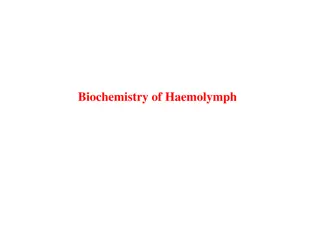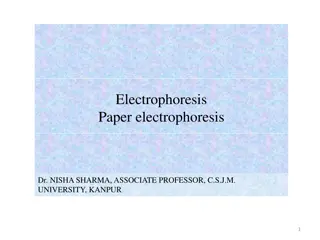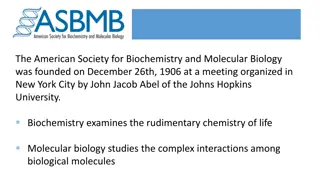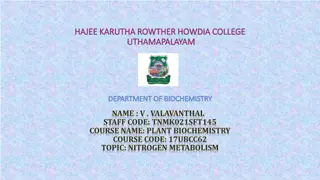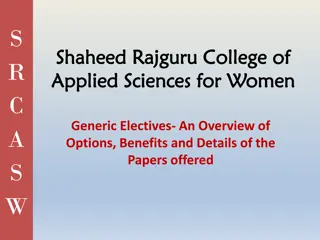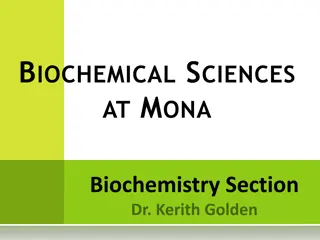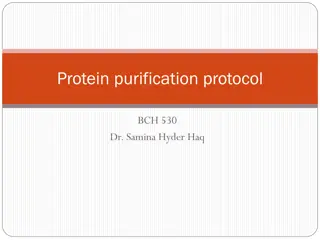Biochemistry
Bioenergetics is the quantitative study of energy transformations in living cells, governed by the laws of thermodynamics. Living systems constantly exchange energy and matter with their surroundings to maintain order while operating within the principles of energy conservation and increasing entropy. Gibbs free energy, enthalpy, and entropy play crucial roles in understanding the energy changes during chemical reactions.
Download Presentation

Please find below an Image/Link to download the presentation.
The content on the website is provided AS IS for your information and personal use only. It may not be sold, licensed, or shared on other websites without obtaining consent from the author.If you encounter any issues during the download, it is possible that the publisher has removed the file from their server.
You are allowed to download the files provided on this website for personal or commercial use, subject to the condition that they are used lawfully. All files are the property of their respective owners.
The content on the website is provided AS IS for your information and personal use only. It may not be sold, licensed, or shared on other websites without obtaining consent from the author.
E N D
Presentation Transcript
Biochemistry 2ndCourse 3rd Stage College of Pharmacy Al-Mustansiriyah University Dr. Basma Al- Sudani Lecture 1 4-5-2020
Bioenergetics and Thermodynamics - Bioenergetics is the quantitative study of the energy transductions that occur in living cells and of the nature and of the function of the chemical processes underlying these transductions - Living cells constantly perform work. They require energy for maintaining their highly organized structures, synthesizing cellular components, generating electric currents, and many other processes. - Bioenergetics is the quantitative study of energy relationships and energy conversions in biological systems. Biological energy transformations obey the laws of thermodynamics.
-The first law is the principle of the conservation of energy: for any physical or chemical change, the total amount of energy in the universe remains constant; energy may change form or it may be transport from one region to another, but it cannot be created or destroyed. -The second law of thermodynamics, which can be stated in several forms, says that the universe always tends toward increasing disorder: in all natural processes, the entropy of the universe increases. -The system : is the collection of matter that is undergoing a particular chemical or physical process; it may be an organism, a cell, or two reacting compounds. The reacting system and its surroundings together constitute the universe. -In the laboratory, some chemical or physical processes can be carried out in isolated or closed systems, in which no material or energy is exchanged with the surroundings. -Living cells and organisms, however, are open systems, exchanging both material and energy with their surroundings; living systems are never at equilibrium with their surroundings, and the constant transactions between system and surroundings explain how organisms can create order within themselves while operating within the second law of thermodynamics.
-Gibbs free energy, G, expresses the amount of energy capable of doing work during a reaction at constant temperature and pressure. When a reaction proceeds with the release of free energy the free-energy change, G, has a negative value and the reaction is said to be exergonic. In endergonic reactions, the system gains free energy and G is positive. -Enthalpy, H, is the heat content of the reacting system. It reflects the number and kinds of chemical bonds in the reactants and products. When a chemical reaction releases heat, it is said to be exothermic; the heat content of the products is less than that of the reactants an H has, by convention, a negative value. -Reacting systems that take up heat from their surroundings are endothermic and have positive values of H. Entropy, S, is a quantitative expression for the randomness or disorder in a system. -When the products of a reaction are less complex and more disordered than the reactants, the reaction is said to proceed with a gain in entropy.
Gibbs free energy, G Express the amount of energy capable of doing work during a reaction at constant temp and pressure. The free energy is a measure of the energy available from a chemical or physical reaction G = G products G reactants All chemical reactions are influenced by two forces: the tendency to achieve the most stable bonding state ( enthalpy, H) and the tendency to achieve the highest degree of randomness, expressed as entropy, S. The net driving force in a reaction is G, the free- energy change, which represents the net effect of these two factors: G = H - T S
Cells Require Sources of Free Energy -Cells are isothermal systems they function at essentially constant temperature (they also function at constant pressure). -Heat flow is not a source of energy for cells, because heat can do work only as it passes to a zone or object at a lower temperature. -The energy that cells can and must use is free energy, described by the Gibbs free-energy function G, which allows prediction of the direction of chemical reactions, their exact equilibrium position, and the amount of work they can in theory perform at constant temperature and pressure. -Heterotrophic cells acquire free energy from nutrient molecules, and photosynthetic cells acquire it from absorbed solar radiation.
Equilibrium constant and standard free energy changes
The standard transformed free-energy change, G , is a physical constant that is characteristic for a given reaction and can be calculated from the equilibrium constant for the reaction: G = - RT ln Keq Actual Free-Energy Changes Depend on Reactant and Product Concentrations We must be careful to distinguish between two different quantities: the free-energy change, _G, and the standard free-energy change, G .Each chemical reaction has a characteristic standard free-energy change, which may be positive, negative, or zero, depending on the equilibrium constant of the reaction. The standard free energy change tells us in which direction and how far a given reaction must go to reach equilibrium when the initial concentration of each component is 1.0 M, the pH is 7.0, the temperature is 25 C, and the pressure is kPa. Thus G is a constant: it has a characteristic, unchanging value for a given reaction. But the actual free-energy change, G, is a function of reactant and product concentrations and of the temperature prevailing during the reaction, which will not necessarily match the standard conditions as defined above.
- The concentration terms in this equation express the effects commonly called mass action, and the term [C][D]/[A][B] is called the mass-action ratio, Q. - In living cells, reactions that would be extremely slow if un catalyzed are caused to proceed, not by supplying additional heat but by lowering the activation energy with an enzyme. - An enzyme provides an alternative reaction pathway with a lower activation energy than the un catalyzed reaction, so that at room temperature a large fraction of the substrate molecules have enough thermal energy to overcome the activation barrier, and the reaction rate increases dramatically. - The free-energy change for a reaction is independent of the pathway by which the reaction occurs; it depends only on the nature and concentration of the initial reactants and the final products. Enzymes cannot, therefore, change equilibrium constants; but they can and do increase the rate at which a reaction proceeds in the direction dictated by thermodynamics.
Standard Free-Energy Changes Are Additive -The free-energy change for a reaction is independent of the pathway by which the reaction occurs. Free- energy changes are additive; the net chemical reaction that results from successive reactions sharing a common intermediate has an overall free-energy change that is the sum of the G values for the individual reactions Phosphoryl Group Transfers and ATP -Heterotrophic cells obtain free energy in a chemical form by the catabolism of nutrient molecules, and they use that energy to make ATP from ADP and Pi. -ATP then donates some of its chemical energy to endergonic processes such as the synthesis of metabolic intermediates and macromolecules from smaller precursors, the transport of substances across membranes against concentration gradients, and mechanical motion. -This donation of energy from ATP generally involves the covalent participation of ATP in the reaction that is to be driven, with the eventual result that ATP is converted to ADP and Pi or, in some reactions, to AMP and 2 Pi.
ATP is the chemical link between catabolism and anabolism - ATP is the chemical link between catabolism and anabolism. It is the energy currency of the living cell. The exergonic conversion of ATP to ADP and Pi, or to AMP and PPi, is coupled to many endergonic reactions and processes. The Free-Energy Change for ATP Hydrolysis Is Large and Negative - The hydrolytic cleavage of the terminal phosphoric acid anhydride (phosphor anhydride) bond in ATP separates one of the three negatively charged phosphates and thus relieves some of the electrostatic repulsion in ATP; the Pi (HPO4) released is stabilized by the formation of several resonance forms not possible in ATP; and ADP2, the other direct product of hydrolysis, immediately ionizes, releasing H+ into a medium of very low [H-] (~10-7 M). Because the concentrations of the direct products of ATP hydrolysis are, in the cell, far below the concentrations at equilibrium , mass action favors the hydrolysis reaction in the cell.
- Although the hydrolysis of ATP is highly exergonic (G -0) -Although the hydrolysis of ATP is highly exergonic ( G -0.5 kJ/mol), the molecule is kinetically stable at pH 7 because the activation energy for ATP hydrolysis is relatively high. -Rapid cleavage of the phosphor anhydride bonds occurs only when catalyzed by an enzyme.
Other Phosphorylated Compounds and Thioesters Also Have Large Free Energies of Hydrolysis -The ability of phosphorylated compound to transfer its phosphoryl group(s) is termed phosphoryl group transfer potential 1. Enol phosphates phosphoenolpyruvate has only one form (enol) and the product (pyruvate) has two possible forms, the product is stabilized relative to the reactant. This is the greatest contributing factor to the high standard free energy of hydrolysis of phosphoenolpyruvate: G =61.9 kJ/mol.
2. Acyle phosphates another three-carbon compound, 1,3-bisphosphoglycerate contains an anhydride bond between the carboxyl group at C-1 and phosphoric acid. Hydrolysis of this acyl phosphate is accompanied by a large, negative, standard free-energy change ( G =-49.3 kJ/mol), which can, again, be explained in terms of the structure of reactant and products. When H2O is added across the anhydride bond of 1,3-bisphosphoglycerate, one of the direct products, 3-phosphoglyceric acid, can immediately lose a proton to give the carboxylate ion, 3- phosphoglycerate, which has two equal lyprobable resonance forms . Removal of the direct product (3- phosphoglyceric acid) and formation of the resonance-stabilized ion favor the forward reaction.
3. Phosphoguanidines.(phosphogens): In phosphocreatine , the PON bond can be hydrolyzed to generate free Creatine and Pi. The release of Pi and the resonance stabilization of Creatine favor the forward reaction. The standard free-energy change of phosphocreatine hydrolysis is again large, - 43.0 kJ/mol. In all these phosphate- releasing reactions, the several resonance forms available to Pi stabilize this product relative to the reactant, contributing to an already negative free-energy change.
4. Thioesters, in which a sulfur atom replaces the usual oxygen in the ester bond, also have large, negative, standard free energies of hydrolysis. Acetyl-coenzyme A, or acetyl-CoA , is one of many thioesters important in metabolism. The acyl group in these compounds is activated for transacylation, condensation, or oxidation-reduction reactions. Thioesters undergo much less resonance stabilization than do oxygen esters; consequently, the difference in free energy between the reactant and its hydrolysis products, which are resonance- stabilized, is greater for thioesters than for comparable oxygen esters .In both cases, hydrolysis of the ester generates a carboxylic acid, which can ionize and assume several resonance forms. Together, these factors result in the large, negative G(- 31 kJ/mol) for acetyl-CoA hydrolysis.
To summarize, for hydrolysis reactions with large, negative, standard free-energy changes, the products are more stable than the reactants for one or more of the following reasons: (1) the bond strain in reactants due to electrostatic repulsion is relieved by charge separation, as for ATP; (2) the products are stabilized by ionization, as for ATP, acyl phosphates, and thioesters (3) the products are stabilized by isomerization (tautomerization), as for phosphoenolpyruvate; and/or (4) the products are stabilized by resonance, as for creatine released from phosphocreatine, carboxylate ion released from acyl phosphates and thioesters, and phosphate (Pi) released from anhydride or ester linkages. 1st home work Would you expected the free energy of hydrolysis of acetyl coenzyme A to be equal to, or greater than that of aceto-acetyl coenzyme A?
A- Consumption of ATP The Role of ATP 1. Early stages of nutrient breakdown 2. Interconversion of nucleoside triphosphates 3. Physiological Processes 4. Additional phosphoanhydride cleavage in highly endergoinc reactions B- Formation of ATP 1. Substrate phosphorylation 2. Oxidative phosphorylation and photophosphorylation 3. Adenyl Kinase reaction .
2nd Home work Write a full report on the ATP molecule 1. How it was discovered? 2. How is determined quantity? 3. Function? 4. On what from it is present inside the cell? 5. How much of it in a typical cell? 6. How much of it is needed for normal daily activity in humans?
